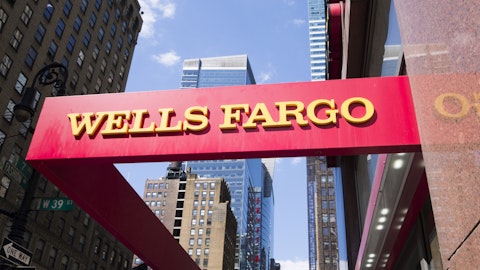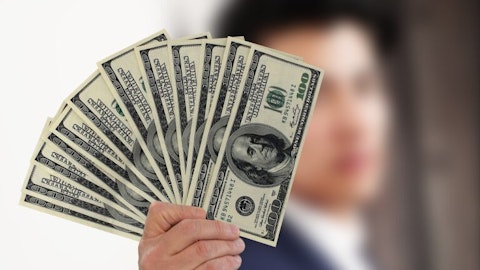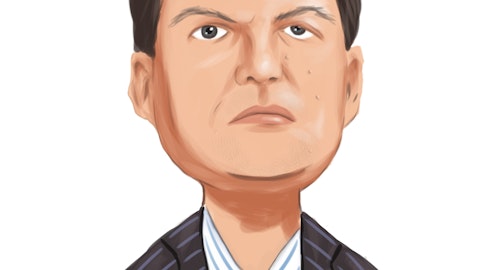In this article, we will look at the 15 countries with the highest savings rate in the world. We have also discussed the saving trends of Americans. If you want to skip our detailed analysis, head straight to the 5 Countries with the Highest Savings Rate in the World.
In the wake of the pandemic, US consumers are diverging from their counterparts in other developed economies by spending their savings rather than increasing them. While Western Europe, Japan, and Canada have seen rises in saving rates, the US stands out with a decline in savings levels post-2022, according to Federal Reserve Bank of New York analysis. The pandemic initially boosted savings worldwide due to business closures and government relief, with the US notably distributing substantial stimulus checks. However, Americans are now swiftly spending these ‘excess savings,’ a phenomenon that has even puzzled economists.
The trend challenges economic norms, as US consumers maintain spending amid inflation and high interest rates, supported by their accumulated savings. Some economists attribute this behavior to the origin of the savings, suggesting that people are more inclined to spend government transfers viewed as ‘unearned.’ Despite skepticism about the concept of ‘excess savings,’ it continues to influence economic discussions.
In Bankrate’s 2024 annual emergency savings report, statistics further confirmed the financial challenges faced by Americans. More than one-third (36%) of adults possess more credit card debt than emergency savings, a concerning trend exacerbated by years of soaring inflation. However, there’s a glimmer of hope as nearly one in three (30%) individuals report bolstering their emergency savings compared to the previous year, signifying a concerted effort towards financial resilience. Despite this, a concerning reality persists: over half of Americans wouldn’t cover a sudden $1,000 expense from their emergency savings, opting instead to borrow money or reduce spending.
The upcoming Federal Reserve meeting on May 1 holds important interest rate implications, with expectations suggesting rates will hold steady between 5.25% to 5.5%. Market sentiment, as gauged by the CME FedWatch Tool and Kalshi, indicates a mere 8% to 12% chance of a rate cut at this meeting. However, forecasts anticipate rate reductions between June and September, contingent upon economic data shifts.
Moreover, the Fed’s March meeting revealed a consensus among policymakers for potential rate cuts in 2024, citing favorable disinflation trends but acknowledging the need for cautious adjustment to avoid either inflation resurgence or harm to employment. The timing of these cuts hinges on incoming economic indicators, with employment stability providing the Fed room to gauge inflation trends before implementing rate adjustments.
Inflation metrics, particularly the Personal Consumption Expenditures inflation rate, play a pivotal role in shaping future rate decisions. The Fed awaits updates on inflation data, expecting a degree of cooling in housing services inflation rates while monitoring potential reversals in certain deflationary trends, such as declining prices for household goods and used cars. As the Fed navigates these economic nuances, market observers anticipate a measured approach to interest rate adjustments, with May’s meeting likely to provide further clarity on the trajectory of future rate cuts.
Before getting into our list of countries with the highest saving rates in the world, let’s look at the best banks for savers.
Citibank Group Inc (NYSE:C) is an excellent option for savers with its diverse range of savings account packages, each offering competitive Annual Percentage Yields (APYs). Their high-yield Accelerate Savings account, with a substantial 3.40% APY, outshines many competitors in the market. Additionally, Citibank Group Inc (NYSE:C)’s expansive network of 700 physical branches and 65,000 surcharge-free ATMs nationwide ensures convenient access to banking services for its customers.
However, it’s important to note that while Citibank Group Inc (NYSE:C)’s Accelerate Savings account offers attractive rates, it comes with certain restrictions, such as the necessity of linking to a checking account and maintaining a higher balance to avoid monthly fees. For individuals unable to access the Accelerate Savings account, Citibank Group Inc (NYSE:C) also provides a standard savings account option with a respectable 0.05% APY, still higher than many offerings from major US banks.
Moreover, when considering the best bank for saving rates in the US, Wells Fargo & Co (NYSE:WFC) is a major brick-and-mortar institution offering competitive options. With its Wells Fargo & Co (NYSE:WFC) Platinum Savings Account, customers can earn an Annual Percentage Yield (APY) ranging from 0.25% to 2.51%, depending on their account balance. This tiered interest rate system incentivizes higher balances, with Relationship Rates available for those who link their savings account to Wells Fargo & Co (NYSE:WFC) Prime or Premier Checking accounts. However, despite these competitive rates within the traditional banking sector, online banks often provide even more attractive rates, regardless of account balance.
On the other hand, Wells Fargo & Co (NYSE:WFC)’s Way2Save Savings Account offers a flat 0.01% APY, irrespective of the account balance. While this account provides perks like low minimum opening deposits and opportunities to waive monthly service fees, its interest rate remains notably low compared to online banking alternatives. When compared to other national banks, Wells Fargo & Co (NYSE:WFC) generally offers slightly higher savings rates, particularly with its Platinum Savings Account.

TaLaNoVa/Shutterstock.com
Methodology
To list the countries with the highest saving rates in the world, we relied on data from the World Bank on Gross Savings Rate (as % of GDP as of 2022). The countries have been presented in an ascending order. According to World Bank, Gross savings are calculated as gross national income less total consumption, plus net transfers.
By the way, Insider Monkey is an investing website that uses a consensus approach to identify the best stock picks of more than 900 hedge funds investing in US stocks. The website tracks the movement of corporate insiders and hedge funds. Our top 10 consensus stock picks of hedge funds outperformed the S&P 500 stock index by more than 140 percentage points over the last 10 years (see the details here). So, if you are looking for the best stock picks to buy, you can benefit from the wisdom of hedge funds and corporate insiders.
15. Cambodia
Gross Savings (% of GDP): 37%
The National Bank of Cambodia (NBC) is spearheading a campaign to instill a culture of saving among citizens and financial institutions. As the bank is trying for emphasize on the importance of saving, NBC deputy governor Yim Leat highlighted that regardless of income level, saving is essential to provide financial security and stability.
14. Indonesia
Gross Savings (% of GDP): 37%
The resurgence of Indonesia’s banking sector can be attributed to several factors, including a major increase in the national savings rate, particularly during the pandemic era. This increase in savings has empowered banks to issue more loans, thereby driving profitability. Additionally, these savings are channeled into productive investments, particularly in infrastructure and industrial development, further fueling the sector’s growth.
13. Denmark
Gross Savings (% of GDP): 37%
Denmark has one of the highest saving rates globally owing to a combination of cultural, economic, and social factors. The country’s strong welfare system provides a safety net, encouraging people to save for future goals rather than relying solely on state support.
12. Uzbekistan
Gross Savings (% of GDP): 38%
In Uzbekistan, the savings habits tend to be unique as traditional banking is less prevalent. Instead, avenues such as livestock investments and foreign currency acquisition are favored. Despite comparable savings rates to other developing nations, formal banking remains underutilized, especially by women.
11. Saudi Arabia
Gross Savings (% of GDP): 40%
Saudi Ministry of Finance has recently introduced Sah, the inaugural individual savings product, in partnership with the National Debt Management Center. Sukuks are Islamic financial certificates similar to bonds, structured to comply with Shariah law. They represent ownership in a tangible asset or project and provide a predetermined return to investors.
10. Vanuatu
Gross Savings (% of GDP): 41%
The country’s traditional communal ownership tends to promote a culture of saving and investment. With limited access to formal financial institutions, it encourages people to save independently as well. Foreign aid and remittances also contribute to national savings, as does a reliance on subsistence agriculture, which encourages self-sufficiency and saving for the future.
9. Azerbaijan
Gross Savings (% of GDP): 43%
In Azerbaijan, changes in the taxation procedure for interest on savings are underway. Previously, a grace period exempted annual interest income on deposits for seven years, but starting from February 1, 2024, banks have been applying a 10% tax on interest income at the source.
8. Singapore
Gross Savings (% of GDP): 43%
In Singapore, Singlife has announced an increase in the base returns of its Singlife Account, a digital insurance savings plan. This adjustment aims to address the challenge faced by 50% of Singaporeans in meeting conditions for maximum interest rates on savings accounts.
7. Algeria
Gross Savings (% of GDP): 44%
Algeria benefits from large revenues generated by its oil and gas exports, providing a substantial inflow of foreign exchange reserves. Additionally, the government’s prudent fiscal policies and strategic investments in infrastructure projects, encourage saving and contribute to national savings.
6. China
Gross Savings (% of GDP): 46%
China’s savings prowess is known globally as it constituted 28% of total global savings in 2023, as per IMF data. This figure is comparable to the combined share of savings from the US and EU, indicating China’s immense economic influence. However, as China’s property boom wanes, managing these savings becomes imperative. The country faces a challenge in transitioning its investment landscape, with a historical savings rate over 40% of GDP. Nevertheless, with a saving rate as high as 46%, China is one of the best countries to save money in Asia.
Click here to see the 5 Countries with the Highest Savings Rate in the World.
Suggested Articles:
- I am 50 Years Old and Have No Retirement Savings
- 20 Best US Cities to Retire with $1 Million in Retirement Savings
- 15 Best Places to Retire If You Have No Savings
Disclosure: None. 15 Countries with the Highest Savings Rate in the World is originally published on Insider Monkey.





